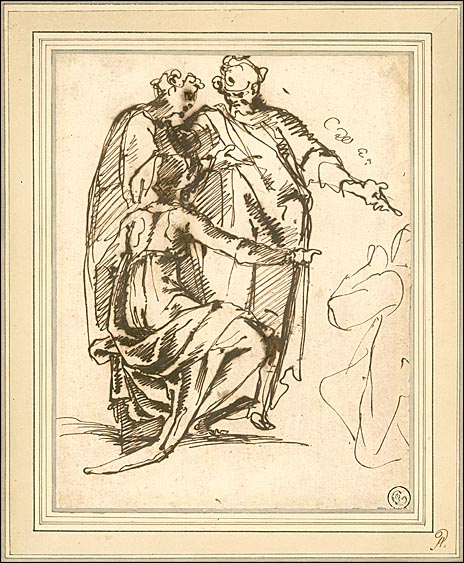MIA N. WEINER
OLD MASTER DRAWINGS & OIL SKETCHES

CHERUBINO ALBERTI
Borgo San Sepolcro 1553 — 1615 Rome
Seated Woman Before Two Standing Men All Gesturing Towards a Supplicant Figure
pen & brown ink. 93/4 x 71/2" (247 x 190 mm). in a few places the ink has bitten into the paper.
an undeciphered monogram on the old mount;
Drs. Richard and Trude Krautheimer (their mark R & TK within a rectangle on verso), New York and Rome.
Cherubino Alberti was both painter and highly respected engraver. He belonged to a family of artists with whom he collaborated on many grand scale decorative projects. His chief work was the fresco decoration of the Sala Clementina in the Vatican which he executed with his brother Giovanni on behalf of Pope Clement VIII. These frescoes date from the 1590's. He drew prodigiously in a late Mannerist style. The Gabinetto Nazionale delle Stampe at the Farnesina in Rome conserves an album of figurative drawings by the Alberti which it had acquired directly from the artists' descendents in 1913. There one finds certain pen and ink drawings very much like the present leaf in the spontaneity and exuberance of the pen line, in the calligraphic treatment of the facial features, in the consequences of the acidity of the ink which swells its contours and eats into the paper.1
Richard Cosway (1740-1821) was a renowned painter of miniatures, a watercolorist, principal painter to the Prince of Wales, and important collector of drawings and prints. He augmented his income by dealing in Old Master paintings.
The Krautheimers, Prof. & Drs. Richard and Trude, were especially interested in Roman drawings and their collection included superb works by Roman Mannerist artists, most notably Taddeo Zuccaro. Yet somehow, despite the fact that they studied their collection of mostly Italian drawings and consulted with many of the field's cognoscenti, the present work eluded their attribution. It was presumably thought by them to be Roman; in fact it is. Moreover, it is a wonderful example of the lively penmanship of one of Rome's more important late Cinquecento artists.
| 1 | K. Herman-Froie, Disegni degli Alberti, Rome, 1983, p. 110, pl. 53; p. 115, pl. 57; p. 147, pl. 87, for example. |